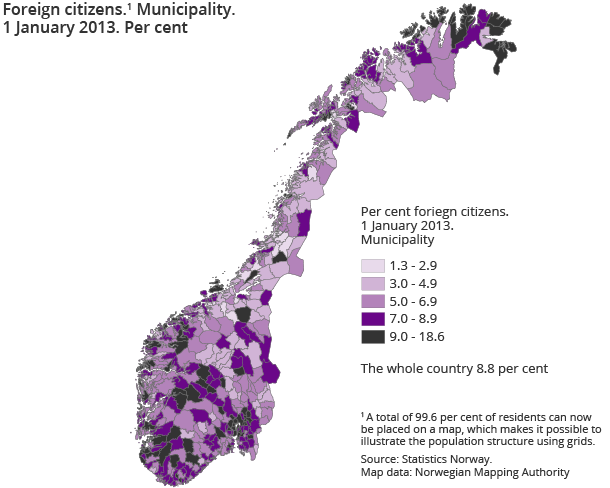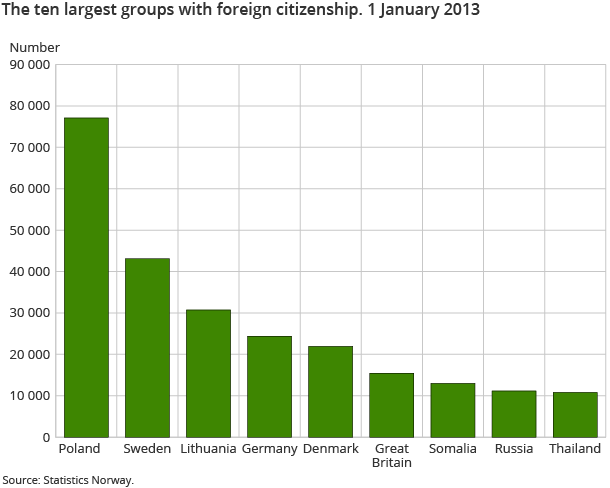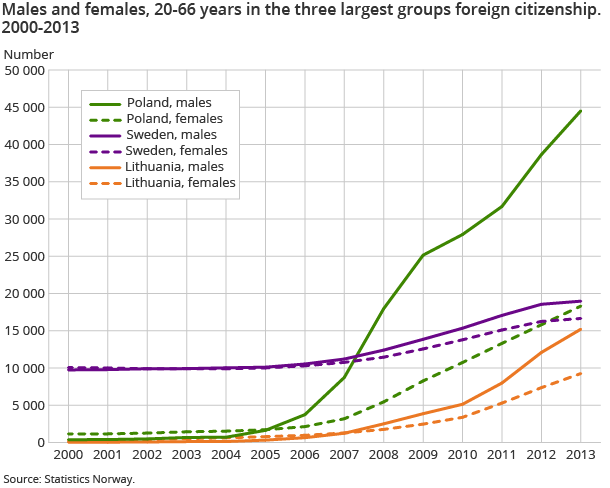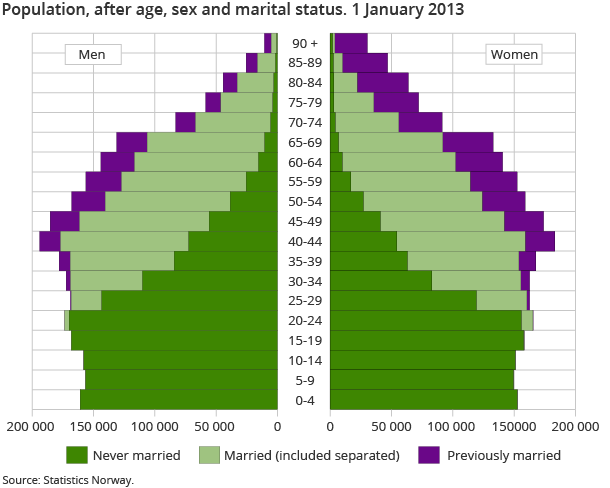Content
Published:
This is an archived release.
Almost 9 per cent with foreign citizenship at start of 2013
At the turn of the year, 449 000 foreign citizens lived in Norway, representing 8.8 per cent of all 5 051 000 residents in the country.
| 2013 | Change in per cent | |||
|---|---|---|---|---|
| 2012 - 2013 | 2008 - 2013 | 2003 - 2013 | ||
| Total | 5 051 275 | 1.3 | 6.6 | 11.0 |
| 0 years | 60 530 | 0.1 | 3.2 | 8.8 |
| 1-5 years | 314 484 | 0.8 | 7.5 | 5.5 |
| 6-12 years | 426 509 | 0.4 | -1.0 | -2.1 |
| 13-15 years | 190 264 | -0.6 | 0.8 | 7.4 |
| 16-19 years | 261 666 | 0.8 | 3.7 | 21.3 |
| 20-44 years | 1 728 068 | 1.4 | 6.9 | 8.1 |
| 45-66 years | 1 396 542 | 1.3 | 8.7 | 19.8 |
| 67-79 years | 451 627 | 4.3 | 14.3 | 12.9 |
| 80 years and over | 221 585 | 0.0 | 1.4 | 8.1 |
During 2012, the number of foreign citizens grew by 41 500 to 449 000, which corresponds to 63 per cent of the total population growth of 65 400 last year. This is the biggest increase in foreign citizens ever, and 3 500 more than in 2011.
The number of Polish citizens had the largest increase in 2012, as for every year since 2004. The growth of 10 500 in 2012 was about 1 000 less than in 2011. At the turn of the year, there were 77 100 persons with Polish citizenship living in Norway, representing the largest group of foreign citizens. The group of Lithuanian citizens had the second highest increase in 2012, with a growth of 6 700 to 30 700 residents as per 1 January. Otherwise, the groups with Eritrea and Somalia citizenship increased the most, by 2 400 and 2 200 respectively in 2012.
The 43 100 Swedish citizens represented the second biggest group of foreign citizens. There are also a large number of Germans and Danes living in Norway, with 24 400 and 21 900 respectively.
Steadily more male Polish citizens
The 77 100 Polish citizens made up 17 per cent of all foreign citizens settled in Norway at the turn of the year. Of these, 62 800, or 81 per cent, were in the age group 20-66 years. This is much more than in the population as a whole, where the corresponding figure for this age group is 62 per cent. Among the 62 800 Polish citizens in the age group 20-66 years, there were much more males than females; 44 500 and 18 300 respectively. The number of males in this age group has increased from 8 700 in 2007, and the growth can be seen in connection with the increase in employment immigration to Norway.
375 000 children under the age of 6
On 1 January, 7.4 per cent of all residents in Norway were under 6 years of age, while 12.2 per cent were 6-15 years and 5.2 per cent were aged 16-19. Around the year 1900, there were twice as many children under the age of 6, with 15 per cent. Since 1900, the number of children under 6 years has varied considerably, between 244 100 (1938) and 394 400 (1972). The number of women aged between 20 and 45 years and how many children they each have has a large impact on the size of the group with young children, together with the level of child mortality and outward and inward migration.
Varying percentages among the elderly
More than 60 per cent of the population were in the age group 20-66 years, while about nine per cent were aged 67-79 years. Those aged 80 years and over represented 4.4 per cent of the total population, with the highest percentage in Hedmark and the lowest in Oslo and Rogaland.
Residents on the mapOpen and readClose
A total of 99.6 per cent of residents can now be placed on a map, which makes it possible to illustrate the population structure using grids.
Contact
-
Magnus Haug
E-mail: magnus.haug@ssb.no
tel.: (+47) 40 81 14 91
-
Karstein Sørlien
E-mail: karstein.sorlien@ssb.no
tel.: (+47) 47 70 16 35
-
Linn Krokedal
E-mail: linn.krokedal@ssb.no
tel.: (+47) 95 47 97 47
-
Anders Sønstebø
E-mail: anders.sonstebo@ssb.no
tel.: (+47) 46 66 37 74
-
Espen Andersen
E-mail: espen.andersen@ssb.no
tel.: (+47) 92 61 00 46
-
Statistics Norway's Information Centre
E-mail: informasjon@ssb.no
tel.: (+47) 21 09 46 42
-
Oppdrag befolkningsstatistikk
E-mail: befolkning@ssb.no




